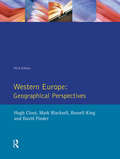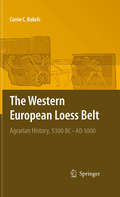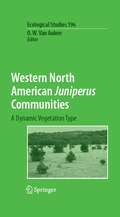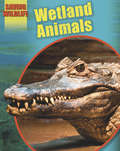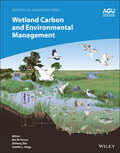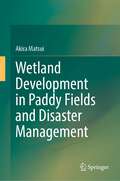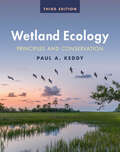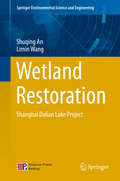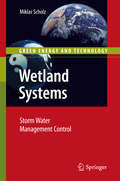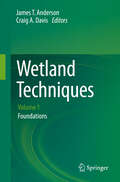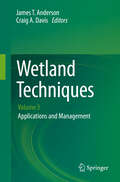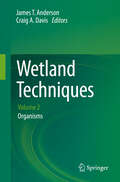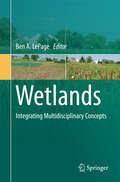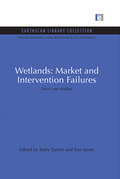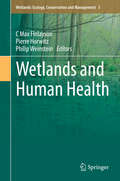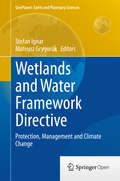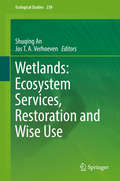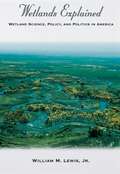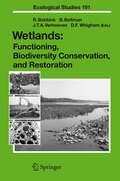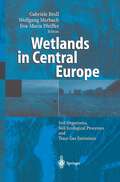- Table View
- List View
Western Europe: Geographical Perspectives
by Hugh Clout Mark Blacksell Russell King David PinderWestern Europe provides a balanced appraisal of common characteristics and shared problems of the eighteen states lying to the west of the former Iron Curtain.
Western Europe: Geographical Perspectives
by Hugh Clout Mark Blacksell Russell King David PinderWestern Europe provides a balanced appraisal of common characteristics and shared problems of the eighteen states lying to the west of the former Iron Curtain.
The Western European Loess Belt: Agrarian History, 5300 BC - AD 1000
by Corrie C. BakelsThis book deals with the early history of agriculture in a defined part of Western Europe: the loess belt west of the river Rhine. It is a well-illustrated book that integrates existing and new information, starting with the first farmers and ending when food production was no longer the chief source of livelihood for the entire population. The loess belt was chosen because it is a region with only one type of soil and climate as these are all-important factors where farming is concerned. Subjects covered are crops, crop cultivation, livestock and livestock handling, the farm and its yard, and the farm in connection with other farms. Crop plants and animals are described, together with their origin. New tools such as the plough, wheen, wagon and scythe are introduced. Groundplans of farm buildings, the history of the outhouse and the presence or absence of hamlets are presented as well, and the impact of farming on the landscape is not forgotten. The loess belt was not an island and the world beyond its boundaries was important for new ideas, new materials and new people. Summarising six millennia of agriculture, the thinking in terms of the Western European loess belt as one agricultural-cultural unit seems justified.
Western North American Juniperus Communities: A Dynamic Vegetation Type (Ecological Studies #196)
by Oscar Van AukenIn North America, Juniperus woodlands occupy approximately 55 million hectares, an area larger than the state of Texas. This title addresses various aspects of the biology, ecology, and management of Juniperus woodlands and savannas, synthesizing past and current research findings as well as proposed research. The book provides ecologists, land managers, and foresters with a solid foundation in Juniperus ecosystems, enabling them to manage the communities for maximum sustained productivity and diversity.
Wet Scrubbers
by Howard D. HeskethA basic technical book on the design and application of gas cleaning technologies that use liquids, first published in the 1980's and used by plant and environmental engineers, regulatory personnel, and others concerned with air pollution. The second edition enlarges the discussion on the theory of
Wet Scrubbers
by Howard D. HeskethA basic technical book on the design and application of gas cleaning technologies that use liquids, first published in the 1980's and used by plant and environmental engineers, regulatory personnel, and others concerned with air pollution. The second edition enlarges the discussion on the theory of
Wetland Animals: Wetland Animals (library Ebook) (Saving Wildlife)
by Sonya NewlandWetland Animals investigates how people are working to save one of our most important ecosystems, and the millions of animals that rely on the world's wetlands for survival.It is part of the Saving Wildlife series, which investigates the world's endangered species in the context of their different environments.
Wetland Carbon and Environmental Management (Geophysical Monograph Series)
by Ken W. Krauss Zhiliang Zhu Camille StaggExplores how the management of wetlands can influence carbon storage and fluxes Wetlands are vital natural assets, including their ability to take-up atmospheric carbon and restrict subsequent carbon loss to facilitate long-term storage. They can be deliberately managed to provide a natural solution to mitigate climate change, as well as to help offset direct losses of wetlands from various land-use changes and natural drivers. Wetland Carbon and Environmental Management presents a collection of wetland research studies from around the world to demonstrate how environmental management can improve carbon sequestration while enhancing wetland health and function. Volume highlights include: Overview of carbon storage in the landscape Introduction to wetland management practices Comparisons of natural, managed, and converted wetlands Impact of wetland management on carbon storage or loss Techniques for scientific assessment of wetland carbon processes Case studies covering tropical, coastal, inland, and northern wetlands Primer for carbon offset trading programs and how wetlands might contribute The American Geophysical Union promotes discovery in Earth and space science for the benefit of humanity. Its publications disseminate scientific knowledge and provide resources for researchers, students, and professionals.
Wetland Carbon and Environmental Management (Geophysical Monograph Series)
by Ken W. Krauss Zhiliang Zhu Camille L. StaggExplores how the management of wetlands can influence carbon storage and fluxes Wetlands are vital natural assets, including their ability to take-up atmospheric carbon and restrict subsequent carbon loss to facilitate long-term storage. They can be deliberately managed to provide a natural solution to mitigate climate change, as well as to help offset direct losses of wetlands from various land-use changes and natural drivers. Wetland Carbon and Environmental Management presents a collection of wetland research studies from around the world to demonstrate how environmental management can improve carbon sequestration while enhancing wetland health and function. Volume highlights include: Overview of carbon storage in the landscape Introduction to wetland management practices Comparisons of natural, managed, and converted wetlands Impact of wetland management on carbon storage or loss Techniques for scientific assessment of wetland carbon processes Case studies covering tropical, coastal, inland, and northern wetlands Primer for carbon offset trading programs and how wetlands might contribute The American Geophysical Union promotes discovery in Earth and space science for the benefit of humanity. Its publications disseminate scientific knowledge and provide resources for researchers, students, and professionals.
Wetland Development in Paddy Fields and Disaster Management
by Akira MatsuiThis book proposes the use of green infrastructure to balance biodiversity conservation and disaster management. Paddy fields are one example of such infrastructure and are the focus of this book. In Japan, abandoned, once-cultivated land is increasing in the paddy fields due to the aging of society and recent depopulation. The author proposes to consolidate such lands and create wetlands because the paddy fields hold water during heavy rains, which prevents floods and protects cities. This is essential, considering that extreme weather conditions have increased the risk of flood damage in Japan. Not only do such wetlands hold water during the flood season, they also provide habitats for aquatic life and places for children to learn about the natural environment. In addition, fish farming in the wetlands will provide food for many people. The increase in water disasters associated with global warming is occurring not only in Japan but globally. The proposal presented in this book will help government officials around the world, especially those involved in urban and rural planning, to consider disaster management—an idea that will be welcomed by both engineers and biologists.
Wetland Restoration: Shanghai Dalian Lake Project (Springer Environmental Science and Engineering #238)
by Shuqing An Limin Wang“Wetland Restoration: Shanghai Dalian Lake Project” introduces the whole Shanghai DaLian wetland restoration project, including the background investigation of the wetland, the overall planning of wetland restoration, its detailed design, engineering construction and engineering effects. This book appeals to readers especially due to its detailed data on wetland restoration. Readers can carry out a similar project step by step from the initial investigation to the last assessment by following the structure presented in this work. Through this book, we can get first-hand information on a wetland restoration, but it can also be valuable for other projects.Professor Shuqing An works at Nanjing University, China.
Wetland Systems: Storm Water Management Control (Green Energy and Technology)
by Miklas ScholzWetland Systems covers broad water and environmental engineering aspects relevant for the drainage and treatment of storm water and wastewater. It provides a descriptive overview of complex ‘black box’ treatment systems and the general design issues involved. Standard and novel design recommendations for predominantly constructed wetlands and related sustainable drainage systems are given to take into account the interests of professional engineers and environmental scientists. Wetland Systems deals comprehensively with not only the design, operation, maintenance and water quality monitoring of traditional and novel wetland systems, but also covers: • Analysis of asset performance • Modelling of treatment processes • Performances of existing infrastructure • Sustainability and economic issues Solutions to pressing water quality problems associated with constructed treatment wetlands, integrated constructed wetlands, farm constructed wetlands and storm water ponds, and other sustainable biological filtration and treatment technologies linked to public health engineering are explained. Case study topics are diverse: natural wetlands and constructed treatment wetlands; sustainable water management; and specific applications, such as wetlands treating hydrocarbons. The research projects discussed are multi-disciplinary, holistic, experimental and modelling-orientated. Wetland Systems is a useful reference for the design and operation of wetland systems by engineers and scientists working for the water industry, non-governmental organisations, local authorities and governmental bodies. It is also a valuable text for undergraduate and postgraduate students, lecturers and researchers in civil and environmental engineering fields.
Wetland Techniques: Volume 1: Foundations
by James T. Anderson and Craig A. DavisWetlands serve many important functions and provide numerous ecological services such as clean water, wildlife habitat, nutrient reduction, and flood control. Wetland science is a relatively young discipline but is a rapidly growing field due to an enhanced understanding of the importance of wetlands and the numerous laws and policies that have been developed to protect these areas. This growth is demonstrated by the creation and growth of the Society of Wetland Scientists which was formed in 1980 and now has a membership of 3,500 people. It is also illustrated by the existence of 2 journals (Wetlands and Wetlands Ecology and Management) devoted entirely to wetlands.To date there has been no practical, comprehensive techniques book centered on wetlands, and written for wetland researchers, students, and managers. This techniques book aims to fill that gap. It is designed to provide an overview of the various methods that have been used or developed by researchers and practitioners to study, monitor, manage, or create wetlands. Including many methods usually found only in the peer-reviewed or gray literature, this 3-volume set fills a major niche for all professionals dealing with wetlands.
Wetland Techniques: Volume 3: Applications and Management
by James T. Anderson and Craig A. DavisWetlands serve many important functions and provide numerous ecological services such as clean water, wildlife habitat, nutrient reduction, and flood control. Wetland science is a relatively young discipline but is a rapidly growing field due to an enhanced understanding of the importance of wetlands and the numerous laws and policies that have been developed to protect these areas. This growth is demonstrated by the creation and growth of the Society of Wetland Scientists which was formed in 1980 and now has a membership of 3,500 people. It is also illustrated by the existence of 2 journals (Wetlands and Wetlands Ecology and Management) devoted entirely to wetlands.To date there has been no practical, comprehensive techniques book centered on wetlands, and written for wetland researchers, students, and managers. This techniques book aims to fill that gap. It is designed to provide an overview of the various methods that have been used or developed by researchers and practitioners to study, monitor, manage, or create wetlands. Including many methods usually found only in the peer-reviewed or gray literature, this 3-volume set fills a major niche for all professionals dealing with wetlands.
Wetland Techniques: Volume 2: Organisms
by James T. Anderson and Craig A. DavisWetlands serve many important functions and provide numerous ecological services such as clean water, wildlife habitat, nutrient reduction, and flood control. Wetland science is a relatively young discipline but is a rapidly growing field due to an enhanced understanding of the importance of wetlands and the numerous laws and policies that have been developed to protect these areas. This growth is demonstrated by the creation and growth of the Society of Wetland Scientists which was formed in 1980 and now has a membership of 3,500 people. It is also illustrated by the existence of 2 journals (Wetlands and Wetlands Ecology and Management) devoted entirely to wetlands.To date there has been no practical, comprehensive techniques book centered on wetlands, and written for wetland researchers, students, and managers. This techniques book aims to fill that gap. It is designed to provide an overview of the various methods that have been used or developed by researchers and practitioners to study, monitor, manage, or create wetlands. Including many methods usually found only in the peer-reviewed or gray literature, this 3-volume set fills a major niche for all professionals dealing with wetlands.
Wetlands: Integrating Multidisciplinary Concepts
by Ben A. LePageThe science of wetlands and our understanding of these complex ecosystems have improved considerably. The emergence of multidisciplinary strategies is providing new opportunities and innovative approaches to address issues such as climate change and coastal protection. This book, with contributions from 19 specialists from academia, government, and industry, provides a trans-disciplinary approach to the understanding wetlands science, drawing together a wide range of expertise. Topics covered include the physical aspects that shape different wetlands around the world, as well as wetlands ecology, regulation, policy, and related social and economic issues.Featuring contributions from some of the world’s leading wetlands researchers and practitioners, this book provides an invaluable resource for undergraduate and post-graduate training in all aspects of wetlands management, conservation, and construction. It is also a useful auxiliary text for researchers working across disciplines in fields such as wetlands science, law, landscape architecture, environmental engineering, conservation ecology, and related disciplines.
Wetlands: Four case studies (Environmental and Resource Economics Set)
by Kerry Turner Tom JonesWetlands are vital and valuable resources, both as rich and unique wildlife habitats, and for the functions they fulfil - providing flood and sediment control and coastal protection, as carbon sinks and pollution buffers, for their role in storing and recycling nutrients, as well as for their recreational value. Too often, however, their true value has been overlooked or underestimated and they have been mismanaged or destroyed as a result. This volume, commissioned by the OECD presents four case studies of the management policies of wetland environments in the UK, USA, France and Spain. They show how both markets and direct intervention have resulted in failure, severely reducing the amount of wetland and jeopardizing the remainder ,and they set out measures that will mitigate damage in the future .Turner and Jones have produced an essential work in the growing area of environmental economics. Originally published in 1991
Wetlands: Four case studies (Environmental and Resource Economics Set)
by Kerry Turner Tom JonesWetlands are vital and valuable resources, both as rich and unique wildlife habitats, and for the functions they fulfil - providing flood and sediment control and coastal protection, as carbon sinks and pollution buffers, for their role in storing and recycling nutrients, as well as for their recreational value. Too often, however, their true value has been overlooked or underestimated and they have been mismanaged or destroyed as a result. This volume, commissioned by the OECD presents four case studies of the management policies of wetland environments in the UK, USA, France and Spain. They show how both markets and direct intervention have resulted in failure, severely reducing the amount of wetland and jeopardizing the remainder ,and they set out measures that will mitigate damage in the future .Turner and Jones have produced an essential work in the growing area of environmental economics. Originally published in 1991
Wetlands and Human Health (Wetlands: Ecology, Conservation and Management #5)
by C Max Finlayson Pierre Horwitz Philip WeinsteinThe book addresses the interactions between wetlands and human health and well-being. A key feature is the linking of ecology-health and the targeting of practitioners and researchers. The environmental health problems of the 21st Century cannot be addressed by the traditional tools of ecologists or epidemiologists working in their respective disciplinary silos; this is clear from the emergence and re-emergence of public health and human well-being problems such as cholera pandemics, mosquito borne disease, and episodic events and disasters (e.g. hurricanes). To tackle these problems requires genuine cross-disciplinary collaboration; a key finding of the recently concluded Millennium Ecosystem Assessment when looking at human well-being and ecosystem health. This book brings the disciplines of ecology and health sciences closer to such a synthesis for researchers, teachers and policy makers interested in or needing information to manage wetlands and human health and well-being issues.
Wetlands and Water Framework Directive: Protection, Management and Climate Change (GeoPlanet: Earth and Planetary Sciences)
by Stefan Ignar Mateusz GrygorukThis book compares the lessons learned from a wetland-perspective approach to the changing climate and the requirements of the Water Framework Directive (WFD) with regard to environmental conservation. Examples from Germany and Poland are discussed due to the efficiency of their respective implementations of water conservation policies. Although the general scientific interest in specific issues such as wetlands, climate change, nature conservation and the WFD enjoy a well established position in international environmental research, these four elements are rarely considered together due to the complexity of the processes, biased scenarios of global change and subjective policy background. Major challenges involved in carrying out environmental conservation actions that assess the potential impacts of climate change and management plans on water bodies are identified. The results of this approach are addressed to practitioners in the field of adaptive management in a wetlands context.
Wetlands: Ecosystem Services, Restoration and Wise Use (Ecological Studies #238)
by Shuqing An Jos T. A. VerhoevenThis volume explores major wetland ecosystem services, such as climate cooling and water quality improvement, and discusses the recent wetland conservation and restoration activities in China and neighboring countries. The role of wetlands in either cooling or warming the climate is analyzed as the net balance between carbon sequestration and emissions of methane and nitrous oxide. Wetlands start off having a net warming effect on the climate but in time switch to net cooling. Further, they remove 40% of the N and P from run-off and groundwater flow in agricultural areas, but wetlands need to amount to 10% of the total catchment area to make a difference.Reflecting on the recent large investment in wetland ecological studies in China and neighboring countries, the book addresses invasive species in coastal wetlands as well as the protection and wise use of tidal flats around the Yellow Sea. It also presents promising regional case studies on wetland restoration. The book is intended for academics, students and practitioners in the field of wetland ecology, management and restoration, as well as consultants and professionals working in conservation, wise use and environmental policy.
Wetlands Explained: Wetland Science, Policy, and Politics in America
by William M. LewisThis book brings together in compact form a broad scientific and sociopolitical view of US wetlands. This primer lays out the science and policy considerations to help in navigating this branch of science that is so central to conservation policy, ecosystem science and wetland regulation. It gives explanations of the attributes, functions and values of our wetlands and shows how and why public attitudes toward wetlands have changed, and the political, legal, and social conflicts that have developed from legislation intended to stem the rapid losses of wetlands. The book describes the role of wetland science in facilitating the evolution of a rational and defensible system for regulating wetlands and will shed light on many of the problems and possibilities facing those who quest to protect and conserve our wetlands.
Wetlands: Functioning, Biodiversity Conservation, and Restoration (Ecological Studies #191)
by Roland Bobbink Boudewijn Beltman Jos T. A. Verhoeven Dennis F. WhighamThis book gives a broad and well-integrated overview of recent major scientific results in wetland science and their applications in natural resource management. After an introduction into the field, 12 chapters contributed by internationally known experts summarize the state of the art on a multitude of topics. The coverage is divided into three sections: Functioning of Plants and Animals in Wetlands; Conservation and Management of Wetlands; and Wetland Restoration and Creation.
Wetlands in Central Europe: Soil Organisms, Soil Ecological Processes and Trace Gas Emissions
by Gabriele Broll Wolfgang Merbach Eva-Maria PfeifferWetlands are very sensitive ecosystems, functioning as a habitat for many organisms. Protection and regeneration of wetlands are of great importance in ecological research and in nature conservation. A huge amount of research has been done on the hydrology, plants and animals in wetlands. Knowledge about soil organisms and soil ecological processes of wetlands is still lacking. This knowledge is a prerequisite for landscape planning purposes or climate change predictions. In the case of climate change, trace gas emissions from wetlands are of great interest. The authors provide an overview of the state-of-the-art on soil ecology in wetlands. The book is divided into the following main chapters: 'Wetlands as habitats for soil organisms', 'Soil ecological processes in fens and floodplains', 'Carbon and nitrogen dynamics in soils with different water regimes' and 'Trace gas emissions'.
